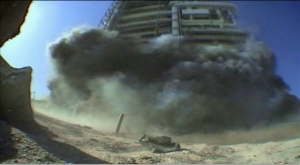Shooting a 3D documentary: Sony EX1’s genlock issue and how to get around it
I’ve turned to the Sony EX line to shoot B cam for our first 3D documentary, after we discovered that the two Canon 7Ds we planned to use can’t send an HDSDI signal to our Transvideo Cineform 3D Monitor.
Two Sony EX3s seem to be an intuitive choice, since this model has genlock in capability.
But we’re shooting an event-based explosive documentary series, Blowdown, in a derelict sports stadium in Salvador, Brazil, so having our gear as light and portable as possible is top priority.
Our stereographer, Sean White, hit the blogosphere to see if there was any way to lighten the load. He found a lead on DoP Alister Chapman’s blog.
It looks like we can pair one Sony EX3 with a Sony EX1: the EX1 lacks a genlock in, but according to Chapman only one of the cameras needs to have it … we can send signal from the EX1 into the EX3 and then send both to the monitor.


